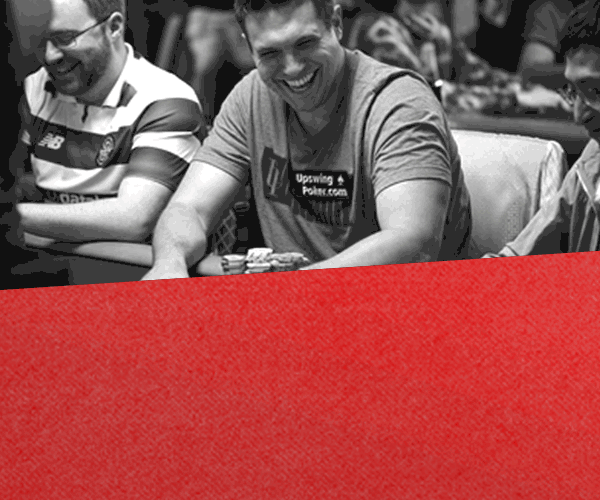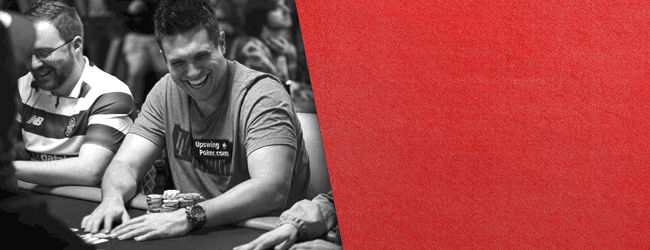This Is Why You Should Use Small Bet Sizes
When I finished writing Applications of No Limit Hold’ em a bit over 4 years ago, my favorite concept to talk about was overbetting.
In many ways, it’s still is my favorite topic. That’s because once the theory behind overbetting is laid out, the situations where overbetting is correct are usually straightforward to see.
Overbets can also be a powerful exploitative tool — many opponents will simply fold way too much to large bets when holding a capped range — and the gap in EV between a medium sized bet and overbet is often quite large.
One concept I briefly mentioned in Applications was the idea of the very small bet, such as one-quarter or one-sixth pot-sized bet, but I spent relatively little time on them.
I had talked about these concepts with a few players much better than myself, but for the most part I thought implementing very small bets into my own game was above my pay grade at the time.
I didn’t want to try to teach a concept I felt I didn’t fully understand or couldn’t implement well. I also didn’t think the ability to make very small bets would likely impact a player’s win-rate by much, so it overall just wasn’t a concept I was too interested or concerned about.
Well, fast forward several years later and I now disagree with my previous assessment. Small bets are a lot more important and a lot easier to implement than I once thought. In fact, this was probably the concept I was most excited to discuss in my new book No-Limit Hold ’em for Advanced Players: Emphasis on Tough Games by TwoPlusTwo Publishing.
In this article, we’ll briefly discuss when small bets are appropriate and why you should care about having the ability to make them.
Understanding Small Bet Sizes
Small bets function very differently based on whether we’re in or out of position.
Note this is different from many other concepts, such as overbetting, since overbets function pretty much the same way regardless of whether we’re in or out of position.
But small bets do not, and that makes them a bit more tricky. So, to best illustrate these concepts, we’re going to go over one hand example where we’re out of position in one and in position in the other.
(I’m intentionally not going to give you a hand in these examples. That’s because I want you think you about your entire range and not getting distracted with any specific holding.)
Small Bets – Out Of Position
Let’s start with an example of betting small when out of position
NL$200 6-max. 100BB Effective Stacks
Preflop ($3) Hero is dealt Xx Xx in the SB
folds to btn. Button raises to $4. Hero 3-bets to $15. bb folds. Button calls.
Flop ($30)
Hero bets $15. Button calls.
Turn ($60)
Alright, so let’s pump the breaks for a moment and summarize where we’re at.
We’re out of position in a 3-bet pot on a A♠ 9♣ 7♠ J♠ board, the pot is $60, and we’ve got $170 behind. We can bet any amount between $0 and $170. That’s because this game was created in America — our forefathers didn’t throw tea in an ocean to piss off the British or win the Battle of Midway and stop the Empire of Japan to be told we can’t bet whatever the hell we want. So, it is your duty as a patriot to consider all bet sizes in all situations.
(If you aren’t from the United States… consider all bet sizes anyway.)
Alright, now I want you to pause for a moment to consider the difference between checking and betting $2 (the minimum) on the turn.
You’d probably check on this turn often, but never bet $2, right? Since you’re constantly taking one line but never taking the other, it’s worthwhile to pause and think about the difference.
Done? Well, the difference is… (Click below when you’re ready for the answer.)
Let’s do one more quick exercise. Think back to our example where the board is A♠ 9♣ 7♠ J♠ and we’re out of position on the turn after having bet on the flop.
What hands can we have on the turn here where you’re unsure of whether to bet or check? In other words, what hands did you 3-bet pre-flop, bet on the A♠ 9♣ 7♠, and are now unsure of what to do with on a J♠ turn? Pause for a moment and think.
(Click below when you’re ready for the answer.)
Ok, so if you’re like most players, when you’re on this turn you immediately think “Should I bet half-pot or check here?” since betting half-pot is probably your default line and how you were originally taught to play poker. But if you can’t figure out which option is best, why not try a one-quarter pot-sized bet instead?
In other words, if it seems close between betting 50% of the pot on this turn or 0% (remember, a check is betting 0%), why not just bet somewhere in between? After all, by betting small you’ll also keep your opponent’s calling range wide, which is important when we have a pretty good-but-not-stellar hand like top-pair top-kicker here.
This concept is discussed in much more detail in No-Limit Hold ’em for Advanced Players: Emphasis on Tough Games, but hopefully you can start to see my point here.
Betting very small when out of position — say 5% or 10% of the pot — isn’t really much different from checking, but there will be times when betting 5%, 10%, or 25% of the pot is better than checking (betting 0%).
Additionally, if you can’t decide if betting half-pot or checking is best when out of position, it’s often best to just bet somewhere in between (say 25%). Small bets out of position are not only often theoretically correct, but they can also be powerful exploitative tools.
Lastly, note small betting ranges can be balanced as well (consisting of a variety of different types of hands so they can’t easily be exploited), and while that’s discussed in the book, that’s going to be beyond the scope of this article.
(Note: Want to learn the methods behind the world class poker players’ successes? Learn more about The Upswing Poker Lab training course by clicking here or below.)
Small Bets – In Position
Alright, let’s move on to betting small in position
NL$200 6-max. 100BB Effective Stacks
Preflop ($3) Hero is dealt Xx Xx on the button
folds to co. CO raises to $4. Hero 3-bets to $14. blinds fold. CO calls.
Flop ($30)
CO checks. Hero $15. CO calls.
Turn ($60)
CO checks.
First, what is the difference between betting $2 on this turn and checking? In other words, is betting very small and checking when in position fundamentally the same thing, or are they different? Pause for a moment and consider why.
(Click below when you’re ready for the answer.)
Whether or not we check or bet will have a huge effect on villain’s range on the following street. For example, imagine we have A♠ Q♥ on the T♠ 6♣ 4♠ 9♣ board and decide to check. What is going to happen when the river comes the 2♦?
Well, our opponent is going to know we can’t be strong, because if we were, why would we have checked the turn on such a dangerous board? Our opponent is going to know our range is weak and capped, and because of that he can make large bets with near impunity knowing we’ll almost never — if not literally never — have anything better than a bluff catcher.
This is unfortunate, but it’s often unavoidable. Sometimes we’ll need to check on wet flops or turns, and if we do happen to get a blank on the following street, we’re pretty much screwed.
Now, let’s imagine that instead of checking with the A♠ Q♥ on the T♠ 6♣ 4♠ 9♣ board, we instead decide to use a one-quarter or one-fifth pot-sized bet. Our opponent calls and the river comes the 2♦. How different is both our range and our opponent’s range on the river now when compared to if we had checked?
Well, since we bet the turn, our range is no longer capped. After all, we could have been betting some very strong hands on the turn for a small amount hoping our opponent would raise.
More importantly, how can our opponent be strong on this river? We gave him the opportunity to check-raise with his sets and straights on the turn, and instead he chose to only call a small bet on an extremely wet board. It’s rarely correct to slowplay such strong hands when out of position on a board this wet, and since the river didn’t improve any hands in his range we can conclude our opponent isn’t strong.
So, that small turn bet resulted in our opponent having a drastically different range on the river than he would have if we had checked on the turn, since he now has the nuts less often. And for this reason, it’s likely going to be very hard for him to call a large river bet.
I’ve always loved quoting stuff in general when playing online poker (it just makes it more fun), and for this reason whenever I bet small on a very wet board and the following street comes a blank, I’ll almost always quote the following:
Yet if we check behind in position on a wet board, it is our opponent who will get to make this quote if the next card comes blank, as now we’re the one who now can’t be strong.
So, while many moons ago I used to think betting small in position is unlikely to be correct, since it doesn’t make the pot much bigger, doesn’t deny much immediate equity, and allows the opponent to check-raise, I now have much more appreciation for the line.
That’s because even if a small flop bet or turn bet won’t deny much immediate equity (since opponents won’t often fold to bets of 15% or 25% of the pot in many situations), small bets allow us to deny equity more aggressively on future streets since we’ll know our opponent’s range is so wide and weak (and often capped).
Give Small Bets a Chance
If you’re currently a player who either bets around ½ pot, 2/3 pot or checks, with maybe the occasional overbet thrown in, hopefully this article has shed some light as to why the ability to bet small can be such a powerful tool.
We’ve only scratched the surface of small bets here, but more information and hand examples can be found No-Limit Hold ’em for Advanced Players: Emphasis on Tough Games as well as in the book discussion forum on TwoPlusTwo.
Learn more about both of Matt Janda’s books on here
(Note: Ready to take your cash game and deep stack tournament skills to the next level? Check out the Upswing Lab, a poker training course covering a huge range of concepts — from flush draws to multi-way pots. Learn more now!)

Read more from UpswingPoker:
- Now that you know when to bet small, why not learn a thing or two about overbetting as well? Check out Overbetting All-In On the River Revealed
- Doug Polk breaks down paired boards with in-depth examples in Paired Boards: 4 Examples That Reveal the Optimal Approach
- Ryan Fee wrote a fantastic article highlighting concepts from Matt’s first book in 4 Things You Must Know to Play Perfect GTO
- Learn more about game theory in poker.